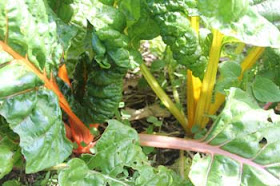 |
| Swiss Chard grows well in a cold frame. |
I grew up reading Organic Gardening and Mother Earth News magazines. As early as the late 1950s, my mother was composting kitchen scraps and garden debris, turning it into rich soil from the directions in Organic Gardening. I remember stories in both magazines about Helen and Scott Nearing, a couple who retired and moved to the Green Mountains of Vermont in 1932 to establish their self-sufficient farmstead. In the articles they wrote, they explained how they were able to grow vegetables the year around, even in the harsh Vermont's winters by using cold frames. In 1952 they moved to Maine where they continued their back to the land experiments in gardening and self-sufficiency.
 |
| This is over a raised bed, 3 1/2 ft x 30 ft. long. |
Over the years I have used the Nearing’s and Coleman's methods for growing winter produce by constructing simple cold frames in my own gardens. Our Ozarks climate is definitely milder than the mountains of Maine, and the methods are simple and even more productive.
The simplest cold frame I’ve used many times over the years is a rectangle built of bales of straw. One bale laid on its side makes up one end and 3 bales laid the same way make up each side, 8 bales in all. I wind up with a very basic cold frame with about 24-30 square feet of growing space. I till up the area inside with a hoe, smooth the soil and plant rows of lettuce, spinach, even onion and radish seed. (Mustard greens, kale, lots of other greens grow well, too). Then I lay down a little loose straw for mulch over the seed bed and cover the cold frame bed with an old window. Some years I use a couple of layers of clear roll plastic and hold it down with scraps of wood.
 |
| With only the sun for warmth, and ground temperatures, the hoop house produces all winter. |
On sunny, warm days I open up the cold frame any time it’s above freezing. At night I pull the plastic or window cover over the top. Even in the dead of winter, when the ground is frozen and snow is piled up, I can go out to the cold frame, open it up and harvest greens and vegetables for the table. And the nice thing is, there are no bug pests in winter!
This year I’m using a somewhat different cold frame, more like Eliot Coleman's method. I used 8 ft. sections of 1 inch plastic p.v.c. pipe, bent into hoops over an existing raised bed. The bed is 3 1/2 feet across and about 30 feet long. I braced the hoops with a single pipe at the top of the peak, held in place with duct tape, then covered the whole frame with 6 mil. clear plastic. Currently I have spinach, cilantro, 3 kinds of lettuce, carrots, onions and radishes growing. Using this method you can replant and grow vegetables all winter long, like the Nearings did on their farmstead in Maine.
 |
| This simple cold frame hoop house produces food all winter. |
This is a bit like Eliot Coleman's method except that I'm using a single layer of plastic rather than the double layer he used. Since I'm in the Ozarks and not in Maine, the extra insulation isn't needed. Rolled plastic has become somewhat expensive, too. I paid $68 for a roll of 100 x 16 ft plastic and about $2.50 each for the 8 ft lengths of 1 inch p.v.c. pipe.
 |
| The bent hoop in the foreground is an intentional brace for the smaller end of the tunnel. |
Here's a read-made cold frame, below, that I bought last year and have used it for 2 seasons. It's too small for our use, but the nice thing is it easily comes apart and stores flat for the summer season. I can grow small amounts of greens without much work.
 |
| It just doesn't get any fresher or local than this! |


I like your variety of subjects. They are always interesting.
ReplyDeleteI can remember both those mags laying in piles around the house as a kid growing up. They look so different than back then.
ReplyDeleteI can not WAIT to do a cold frame next year. My guitar teacher just told me about hers from this winter and showed me a picture of a big bowl of salad picked on a mid-west winter's day, WOW!
ReplyDelete